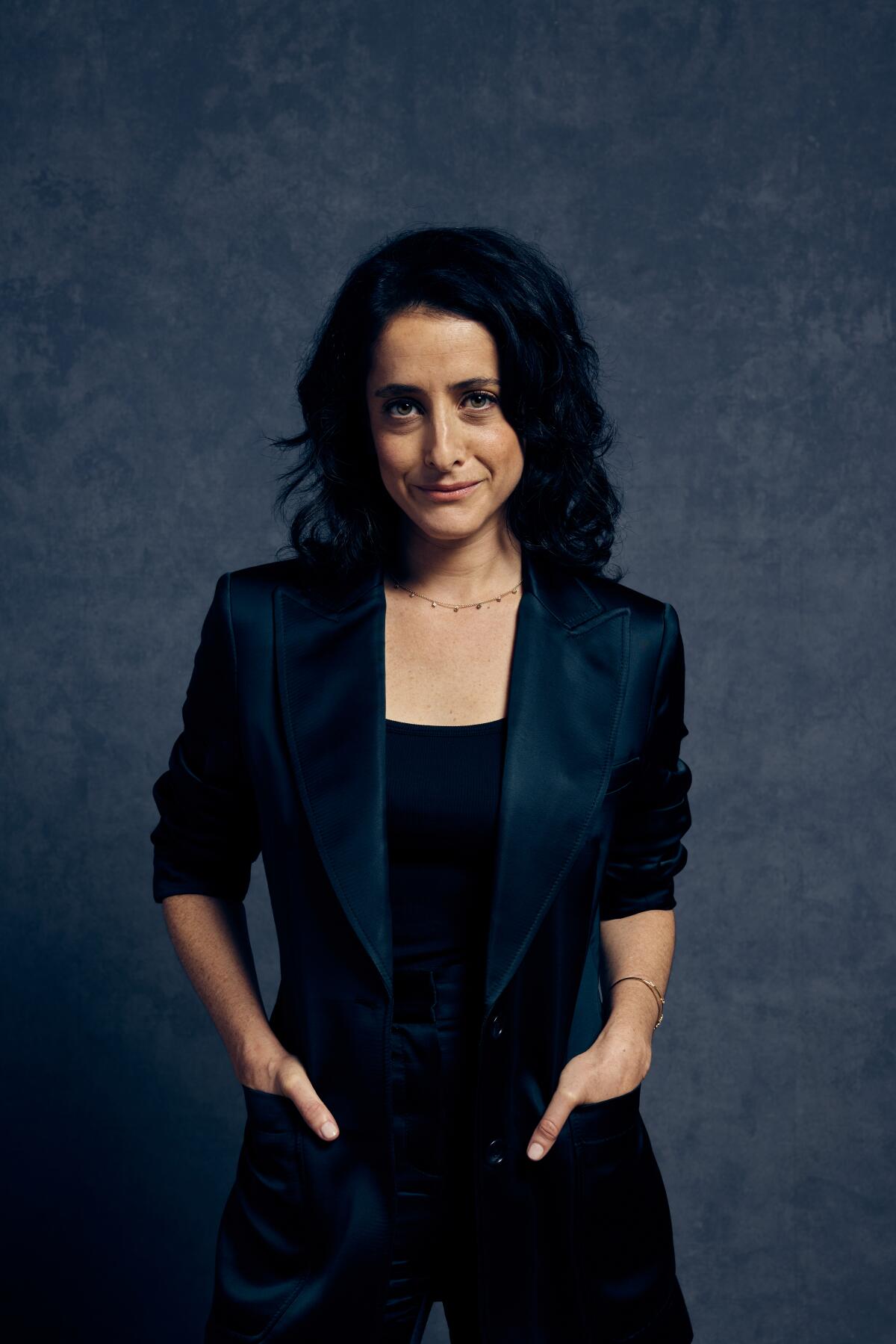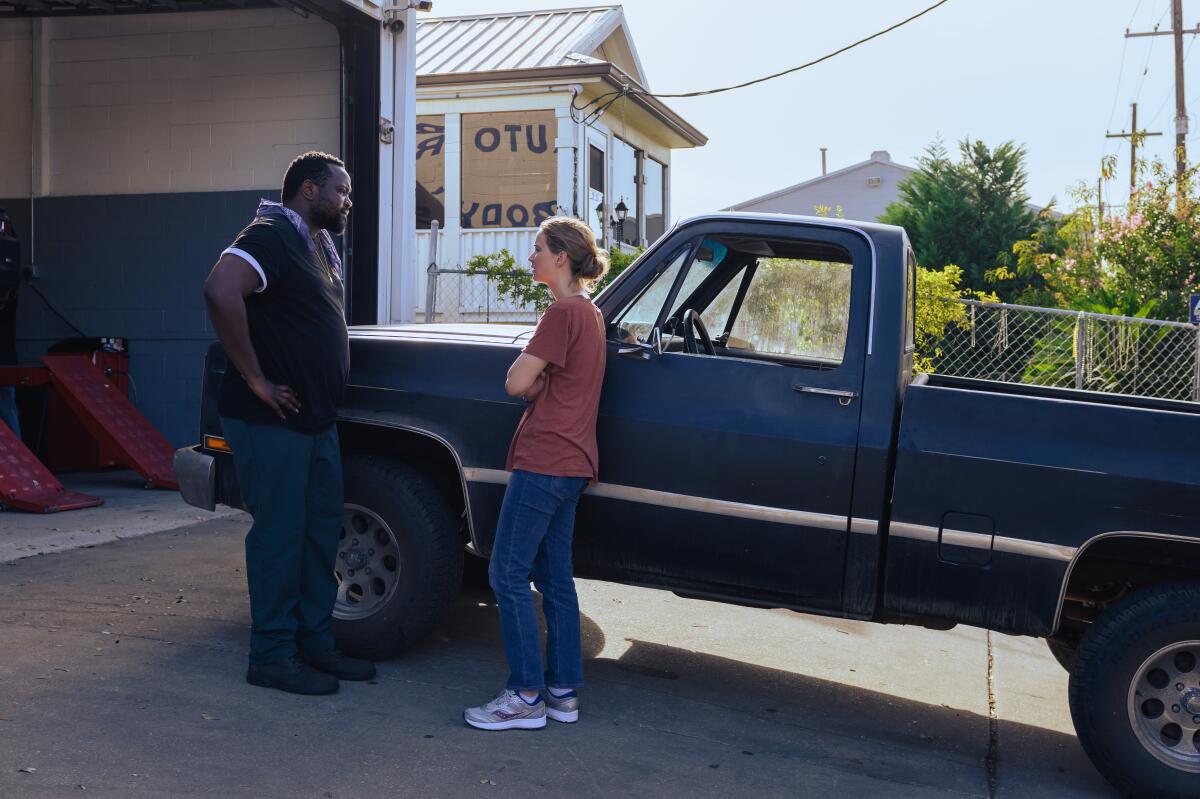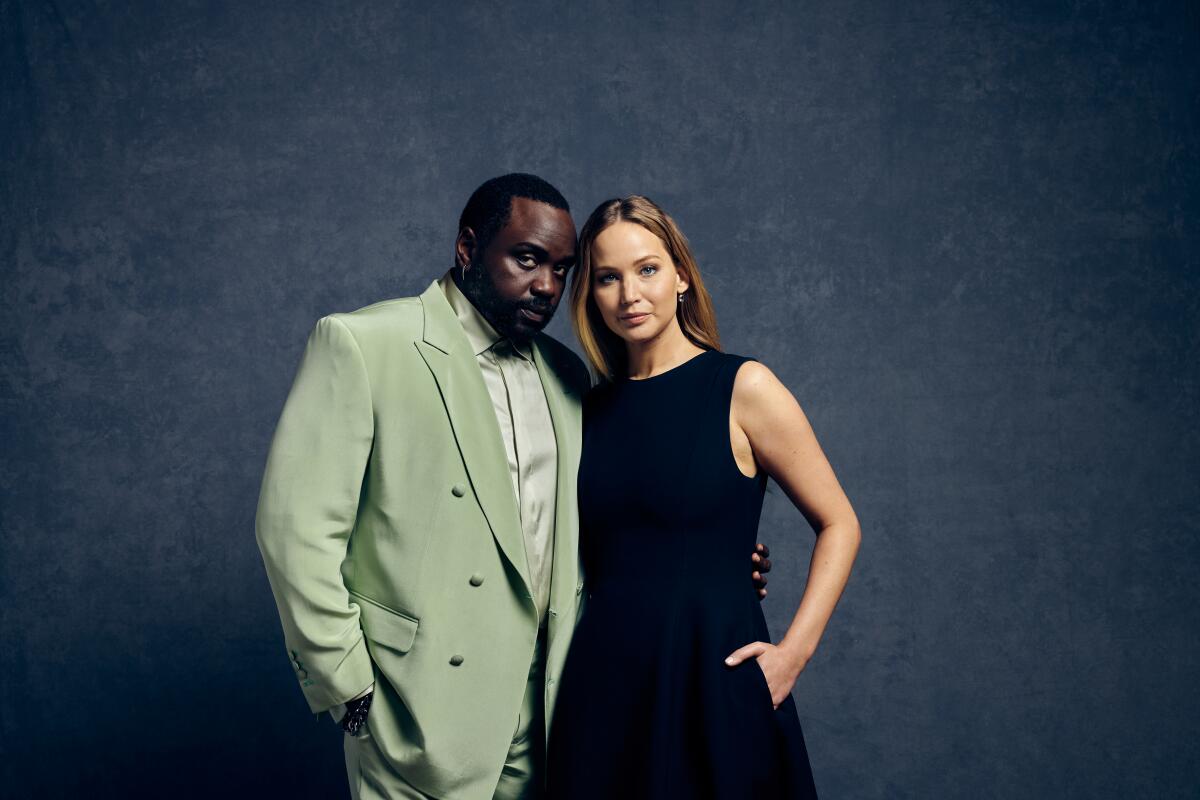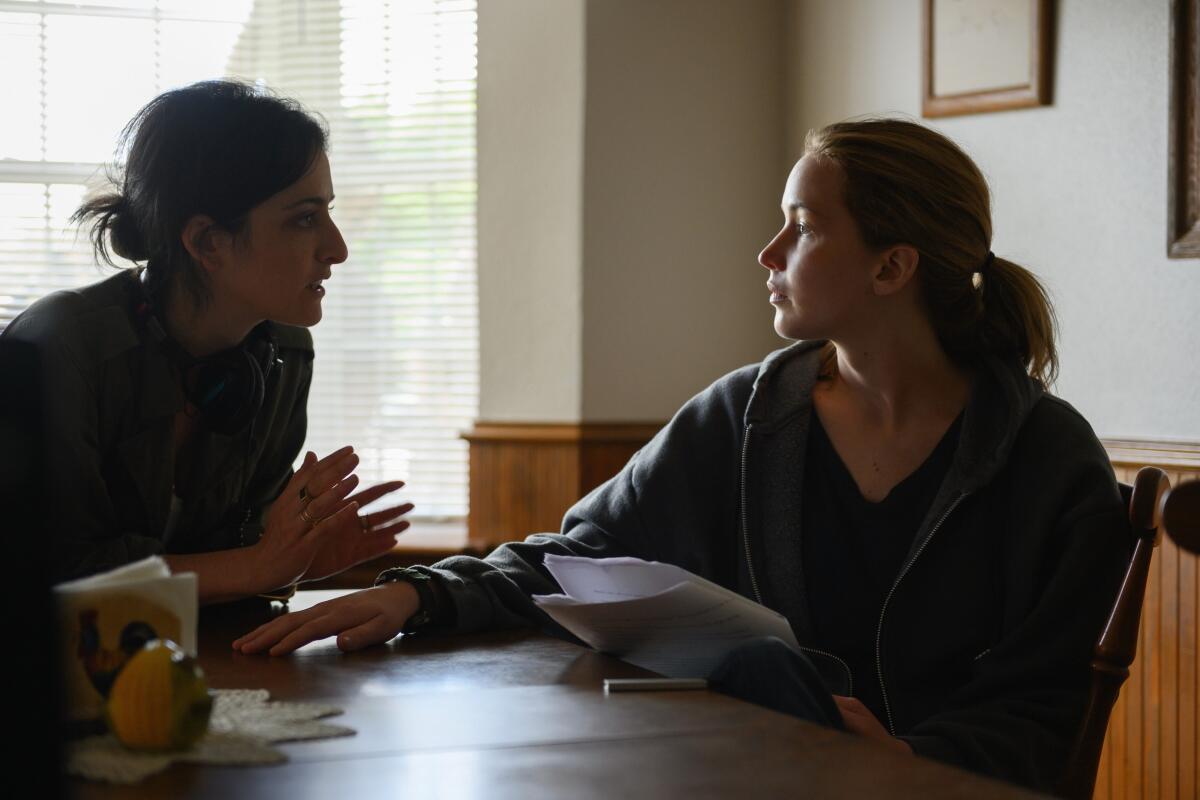‘Causeway’s’ Lila Neugebauer on directing Jennifer Lawrence and the joy of Elaine May

- Share via
The new film “Causeway,” in theaters and streaming on Apple TV+, centers on two remarkably low-key but nevertheless riveting performances by Jennifer Lawrence and Brian Tyree Henry. The film is the first produced by Lawrence and is also the debut feature for director Lila Neugebauer.
Neugebauer is among the most acclaimed directors on the New York theater scene, having directed the world premieres of Sarah DeLappe’s “The Wolves,” Branden Jacob-Jenkins’ “Everybody” and Annie Baker’s “The Antipodes.” She made her Broadway debut with the 2018 production of Kenneth Lonergan’s “The Waverly Gallery” that was nominated for two Tonys, winning the award for lead actress in a play for Elaine May.
“Causeway,” from a screenplay credited to novelists Elizabeth Sanders (“The Last Light”), Ottessa Moshfegh (“My Year of Rest and Relaxation”) and Luke Goebel (“Fourteen Stories, None of Them Are Yours”), opens with Lynsey (Lawrence), having returned to the U.S. from a tour of duty in Afghanistan with a traumatic brain injury, painstakingly relearning how to walk, hold objects, care for herself and simply remember things.
Back at her mother’s house in New Orleans, she gets a job cleaning pools and strikes up a halting, tentative friendship with James (Henry), a mechanic patiently trying to fix her broken-down pickup truck. They each find comfort in the other, two people trying to move through the traumas that have come to define their lives.
The film has a most unusual production history, with a break of two years in the middle of production. Neugebauer sat for an interview during September’s Toronto International Film Festival, on the morning of the world premiere of “Causeway.”

This season, there are a number of other theater directors with films coming out, such as Michael Grandage, Martin McDonagh and Sam Mendes. What do you think keeps attracting theater people to cinema?
Lila Neugebauer: First of all, I’m quite delighted and honored to be put in a list with the people you just mentioned. The processes of filmmaking and directing a play are, in my experience, radically dissimilar — the structure of the process, the nature of how time operates in the mediums, in process and in the outcome, the experience of time. But one of the joyful revelations of directing a film for the first time is, to me, how completely aligned the impulses are at the core. The primacy of visual composition, the centrality of the conversation with the actor and the kind of joyful athleticism of the collaborative conversation with everyone in the room, or at least that’s how I like to work. I guess I would say the connection to me feels intuitive, and it’s my great wish that many more of my peers and friends from the New York theater world might find their way behind a camera.
There’s two editors credited on the film. What was it like for you being in the editing room?
Neugebauer: The context for that reality is in part that we started shooting this film in the summer of 2019 and we encountered some setbacks, inclusive of but not limited to heat waves, flash flooding, hurricane and an evacuation from a hurricane. And by the time we were able to resume, we encountered another setback, which was a global pandemic. So we resumed two years later. The first block of my editing was spent with Luke Johnson. And the second block of my editing was spent with Rob Frazen. I would say that my collaboration with Luke was instrumental in crystallizing the core thrust of the film. By the time I was with Rob, we had completed photography, but that process entailed far more than filling in the holes. Because of course, everything inside of a film is talking to itself and the recalibration of performance architecture, temporality and story structure, was reborn in that process and rearchitected by virtue of having everything that we needed.
In her recent Vogue profile, Jennifer Lawrence talked about how much the story changed from one period of filming to the other, including the decision not to include flashbacks filmed depicting her character’s time in Afghanistan. For you, how did the story evolve when you came back?
Neugebauer: I mean, the cat’s outta the bag, we shot flashbacks. And you hear it is a cliché, but you hear about killing your darlings and then you get to live it. That photography was visually arresting. The performances were incredible. But it became apparent to me that the strongest version of this film lived exclusively in the present tense. And I would add that the singular chemistry between Jen and Brian as actors and as people was so apparent that that story shifted towards the center of the film.

Are you surprised at all by the movie it’s become? Is the movie you ended up with the movie you thought you were making when you started?
Neugebauer: It has evolved. And I would say that in everything I’ve ever made, I’ve tried to listen to what the thing wants to be. My point of view is that you come in intensely prepared and then you assume nothing. You do your research, you do your preparation, you have a line of attack — and I learned this from theater — but to not recognize what’s actually live in front of you is to miss the opportunity of making [the work] with other people.
I think this is a film that revealed itself to me in the course of making it, and at the same time, its core DNA is absolutely rooted in the original draft of the screenplay that I read, which was an adaptation of an unpublished novella by a woman named Elizabeth Sanders, a fantastic first-time screenwriter. That material then benefited from the remarkable contributions of Ottessa Moshfegh and Luke Goebel. And then as I suspect is true in basically any filmmaking processes, there is the movie on the page, the movie you shoot and the movie you edit. [Production designer] Jack Fisk told me that on day one of prep, but I also had to live that to really understand it.
Since I saw the movie, I’ve had a hard time describing it to people, because when you say it’s about this female soldier with a traumatic brain injury, it sounds a lot more dour than it is. How do you describe the feel and tone of the movie?
Neugebauer: I kind of love that you had a hard time describing it. From my life in the theater, I’m drawn to experiences that upon leaving you can’t reduce to a satisfying anecdote. I am drawn to experiences that in some way exceed my capacity to distill them perfectly because they can only be encountered in their presence. But to actually answer your question, I guess I would say, the story follows an intimate portrait of a woman struggling to adjust to her life in her home, in New Orleans, after a traumatic injury, and it centers on the beginning of a relationship with this mechanic and an unexpected connection that they begin to forge. I think the film is a patient, careful excavation of how we actually begin to change, how we cope, how we begin to heal, in the process, reaching out, retreating, trying to connect, self-protecting. And that journey in this particular film is charted one, seemingly small, sometimes painful, sometimes revelatory, but hopefully ultimately meaningful step at a time.
Jennifer’s performance is something that’s going to surprise people. It is not a performance of movie star polish. There’s something really unvarnished about it. Can you talk about your collaboration to bring that out?
Neugebauer: The first two weeks that we met, we sat at her kitchen table and we read through the script one page at a time, just reading it and talking about it and getting to know each other. We did not talk explicitly about what we wanted her performance to look like or feel like; we were immersing ourselves in the psyche of this character together. What I have been struck by in her work in this film personally is a capacity I knew she had, that she can convey such a raw depth of feeling in such a restrained, understated register. Which I think requires a kind of discipline that I knew she possessed.
The dynamic between Lawrence‘s character and Henry‘s character is so unique. As a viewer, you’re not exactly rooting for them to get together in a romantic way, it’s something else. You want them to just kind of be friends and help each other. Was that a difficult dynamic to mine, to not have it fall into the conventional, will they/won’t they of a romance?
Neugebauer: I’m endlessly fascinated by the ways in which the project of building any kind of meaningful intimacy is so often characterized by contradictory impulses to be vulnerable and to protect ourselves and that kind of dance that unfolds between them. It’s unique to the humanity of their characters and to how Jen and Brian so specifically imagined those characters.

You directed Elaine May to a Tony Award in “The Waverly Gallery.” At this point, she is a genuine national treasure. What was it like working with her?
Neugebauer: I mean, she’s kind of my idol. She’s everything you want her to be and more. She’s utterly hilarious. She’s the best storyteller I’ve ever met. When you start a rehearsal process with table work, you sit around a table and you read through the play and start to talk about the scenes and ask foundational questions. And at the beginning of the day, there’s a little small talk, drinking your coffee, and people would ask Elaine questions and she would tell us stories. And over the course of the process, I noticed that we all started coming earlier and earlier. Rehearsal starts at 10, we’d get there like 9:50, then we’d be there at like 9:43. Then suddenly people were there at 9:30 because we just wanted to listen to her talk.
You can think the scene is wired a certain way. And then Elaine kind of shifts the prism of the scene and suddenly you realize there’s this other way into its logic that is revelatory in this whole other way. She’s brilliant. My obsession with Elaine began at a very early age, so I would just say that I can’t wait to see whatever she produces next. She has a lot left to do.
Well, that gives me plenty to work with. Thank you so much for your time. I appreciate it.
Neugebauer: Can I just tell you one more thing? There’s only one more thing I want you to know, because it’s just too important to the film for me not to mention. It is the people I talked to when I was making this film. I knew from the outset that I couldn’t, and wouldn’t, make this film without meaningfully consulting with medical experts in the field of traumatic brain injury and with people who had lived this experience, and the conversations that I had with VA medical professionals with expertise in traumatic brain injury and with veterans and U.S. armed forces service members, they were just so indispensable to the creation of this film. It wouldn’t exist without them.
What did you learn from those conversations?
Neugebauer: It’s gonna sound really hyperbolic, but those were life-changing conversations in terms of my education on what inspires different people to enlist, their experiences deployed and the challenges they face upon returning home. I’m in awe of the medical professionals I talked to and the astonishing care that they are providing to a population that needs that care. And I am also aware now that there are great numbers in that population that are struggling to access care. So I would say my awareness of that is quite heightened now.
More to Read
Only good movies
Get the Indie Focus newsletter, Mark Olsen's weekly guide to the world of cinema.
You may occasionally receive promotional content from the Los Angeles Times.











